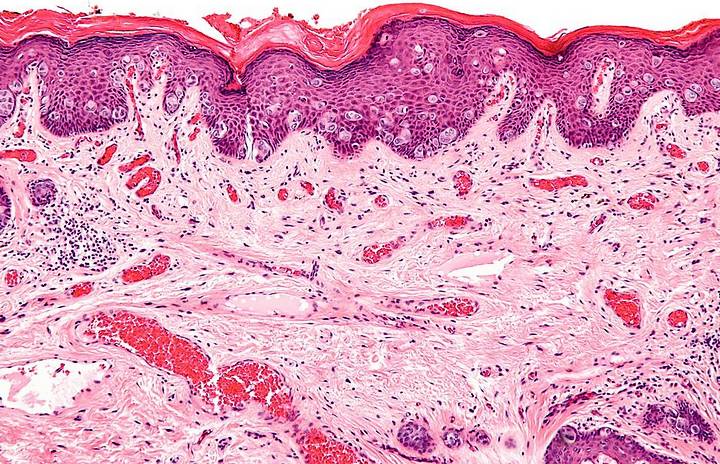
The enlarged epidermal cells shown in the biopsy above are indicative of extramammary paget disease but there can be other causes. Even with definitive stain tests, Paget’s disease of the breast may give a very similar result.
Visible symptoms, such as a rash and scaliness, or redness on the skin are further pointers. Along with the eye of an experienced consultant, use of the latest form of confocal microscopy may be valuable in mapping the disease, for diagnosis and moving forward.
Often known by the acronym EMPD, extramammary paget disease is a form of cancer which arises in the upper layer of skin. The name comes from similarities in appearance to mammary Paget disease, on the breasts but EMPD occurs in men, or women.
Symptoms most often appear in the armpits, anal, or genital areas. They can be mistaken for signs of eczema, as they include a series, of itchy, to a degree burning lesions, commonly made worse by scratching.
Pain and surface bleeding may occur, followed by the lesions forming into a red, crusty overlay. Correct diagnosis before, or as soon as possible after this stage is a valuable step, although such a rare condition can be misdiagnosed.
EMPD & Confocal Microscopy
As EMPD appears similar to several other skin diseases, a biopsy and microscopic analysis is normally used. This is intended to detect Paget cells, along with other signs, although care is needed to distinguish them from early melanoma.
A more modern technique called reflectance confocal microscopy has been tested as a diagnostic alternative. Clinical research to date offers sound results, especially for recurrent, or persistent EMPD.
Confocal microscopy is also helpful to map the affected area at different stages. This improves outcome, by reducing rates of incomplete excision from a conventional approach and rates of recurrence.
Whilst a biopsy could still be needed, confocal microscopy may avoid this, in sensitive areas. As one of the few clinics in the UK to offer the technique, Skin Care Network naturally make confocal microscopy available.
Although EMPD is not dangerous in the sense that melanoma is, there can be serious, or debilitating cases and the condition is linked to other cancers. Using the best diagnostic tools makes sense and leads to correct ongoing care.
Treatment For EMPD
Treatment should reflect your individual condition. There can be cases where topical treatments will help, perhaps laser ablation, or photodynamic therapy.
A form of surgery known as wide local excision is a more common answer, although as with diagnosis, there are alternatives. A specialist approach called Mohs surgery may be a useful choice, which minimises tissue loss.
Treatment for extramammary paget disease should also include follow up examinations at regular, although reducing intervals. EMPD is by nature a recurrent disease and catching a return early avoids in depth treatment.
The latest techniques and a good understanding of EMPD can still see this gone, skin cancer treatment has advanced in recent years. By all means get in touch with our friendly staff for further information.
You may find the options below useful:
- Save time with an intuitive search on: Skin Cancer Diagnosis & Treatment.
- Up to date news, research and insights: Our Dedicated Skin Cancer Blog.
For any advice, or to arrange a dermatology appointment, call 020 8441 1043, or send an email via the Make An Appointment button below.
